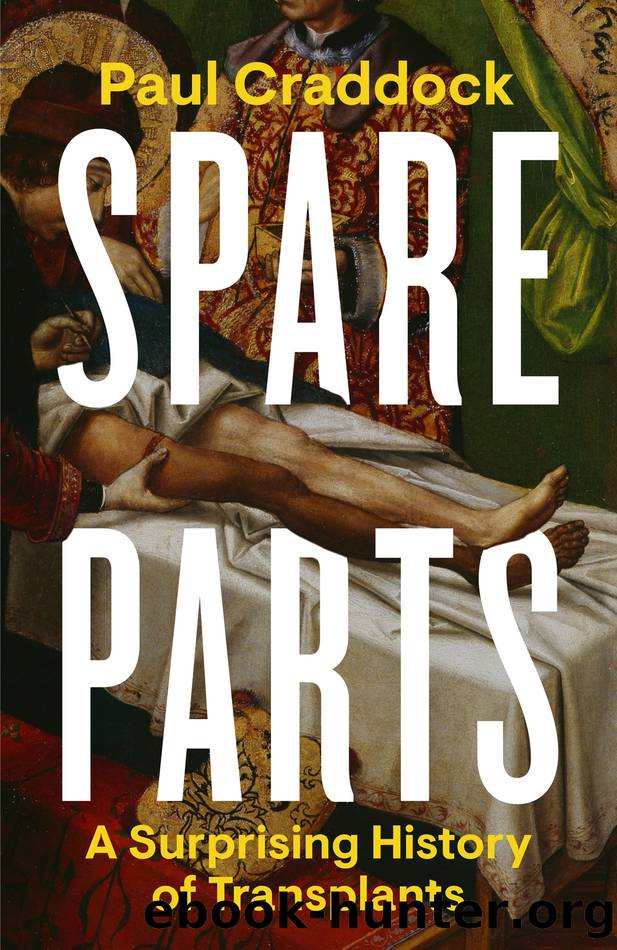Spare Parts by Paul Craddock

Author:Paul Craddock [Craddock, Paul]
Language: eng
Format: epub
Publisher: Penguin Books Ltd
Published: 2020-09-09T16:00:00+00:00
By the time Hunter did these experiments, enough tooth transplants had already been performed to merit coverage in a peculiarly eighteenth-century kind of literature called the âitâ narrative.54 âItâ narratives â something we donât hear much about any more â were stories that followed the adventures of an inanimate object. This could be a teacup, a banknote, a reading desk, or even an atom. In one unattributed story from 1759, The Sedan, the reader follows the adventures of a sedan chair as it carries people around the city. One of its passengers shows off her transplanted smile, and a little boy shouts out, âAye, I know you, and I know my own tooth too from all the rest. Give me my tooth! Give me my tooth!â But he doesnât want it for himself. âMy mother is angry with me for selling it, and says they are not mine but hers till I go out âprentice.â And he let them go for half a guinea when he could have got five.55
Such a situation with the rich buying body parts from the poor would only become more frequent as the century progressed. And now, with scientific âproofâ that tooth transplants worked, it was Hunterâs turn to try his hand at it. He advertised for âdonorsâ, and poor children flocked to sell their teeth, grimly aware that they owned something worth money. The rotten-stumped rich were pampered as they awaited their new teeth, which Hunter fastened in with silk thread or seaweed. With his mind firmly on the physical process itself, he later reported that the transplants worked because of a âvital principleâ establishing a connection with the new part, bringing it back to life.
Like the Boerhaavian vitalists who came before him, Hunter believed life was a physical thing, an invisible particle that couldnât be seen or even detected by scientific instruments. But Hunter didnât buy the nervous vitalism of his predecessors. After copious experiments on animals living and dead, he noticed that he could find life even where nerves never existed or had withered away. Nerves could, at best, be responsible for the higher faculties of the mind, but not for life itself. He launched his own search to find the one part of the body responsible for life, taking years to amass and study his vast plant and animal specimen collection. Comparing once-living specimens with one another, he looked for a common denominator, reasoning that this would be the body part he was looking for. The brain was an early candidate. Perhaps life came from the brain, but no: starfish existed without brains, and they were clearly alive. Other creatures lived without hearts, so they were out, too. The only thing common to every living thing was some kind of circulating â or at least distributed â fluid.
Hunter cited the blood-transfusion experiments of the previous century as proof of âthe uniform nature of the bloodâ. Even though blood had a variety of colours and types, he reasoned it was the only thing every human, animal and plant had in common.
Download
This site does not store any files on its server. We only index and link to content provided by other sites. Please contact the content providers to delete copyright contents if any and email us, we'll remove relevant links or contents immediately.
Spare by Prince Harry The Duke of Sussex(5077)
Machine Learning at Scale with H2O by Gregory Keys | David Whiting(4192)
Fairy Tale by Stephen King(3221)
Will by Will Smith(2795)
Hooked: A Dark, Contemporary Romance (Never After Series) by Emily McIntire(2502)
The Bullet Journal Method by Ryder Carroll(2487)
Rationality by Steven Pinker(2291)
Can't Hurt Me: Master Your Mind and Defy the Odds - Clean Edition by David Goggins(2230)
It Starts With Us (It Ends with Us #2) by Colleen Hoover(2203)
Friends, Lovers, and the Big Terrible Thing by Matthew Perry(2125)
The Becoming by Nora Roberts(2091)
Love on the Brain by Ali Hazelwood(1965)
HBR's 10 Must Reads 2022 by Harvard Business Review(1779)
The Strength In Our Scars by Bianca Sparacino(1778)
A Short History of War by Jeremy Black(1764)
Leviathan Falls (The Expanse Book 9) by James S. A. Corey(1651)
515945210 by Unknown(1602)
A Game of Thrones (The Illustrated Edition) by George R. R. Martin(1594)
Bewilderment by Richard Powers(1541)
